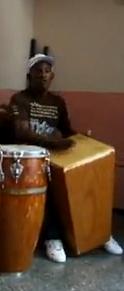Cajón de rumba on:
[Wikipedia]
[Google]
[Amazon]

 The cajones de rumba are wooden boxes used as rhythmic
The cajones de rumba are wooden boxes used as rhythmic
History of the cajón
{{DEFAULTSORT:Cajon de rumba Idiophones Cuban musical instruments
 The cajones de rumba are wooden boxes used as rhythmic
The cajones de rumba are wooden boxes used as rhythmic percussion instrument
A percussion instrument is a musical instrument that is sounded by being struck or scraped by a beater including attached or enclosed beaters or rattles struck, scraped or rubbed by hand or struck against another similar instrument. Exc ...
s in some styles of Cuban rumba
Rumba is a secular genre of Cuban music involving dance, percussion, and song. It originated in the northern regions of Cuba, mainly in urban Havana and Matanzas, during the late 19th century. It is based on African music and dance traditions, ...
. There are different types of cajones, namely the ''cajón tumbadora'', the ''cajón bajo'' and the ''cajita'', all of which are hand-struck.
Cajones arrived to the docks of Matanzas
Matanzas (Cuban ) is the capital of the Cuban province of Matanzas. Known for its poets, culture, and Afro-Cuban folklore, it is located on the northern shore of the island of Cuba, on the Bay of Matanzas (Spanish ''Bahia de Matanzas''), east ...
and Havana
Havana (; Spanish: ''La Habana'' ) is the capital and largest city of Cuba. The heart of the La Habana Province, Havana is the country's main port and commercial center.
in the 19th century. They were full of imported fish, mainly cod, but quickly repurposed as drums by the Afro-Cuban dockworkers. The big boxes were the precursors of the modern tumbadora
The conga, also known as tumbadora, is a tall, narrow, single-headed drum from Cuba. Congas are staved like barrels and classified into three types: quinto (lead drum, highest), tres dos or tres golpes (middle), and tumba or salidor (lowest) ...
and the small ones corresponded to the modern quinto (the smallest, lead conga drum). The equivalent of claves
Claves (; ) are a percussion instrument consisting of a pair of short, wooden sticks about 20–25 centimeters (8–10 inches) long and about 2.5 centimeters (1 inch) in diameter. Although traditionally made of wood (typically rosewood, ebony o ...
were two wooden spoons. Although cajones were mostly replaced by tumbadoras by the early 20th century, they are played in contemporary styles such as guarapachangueo
Rumba is a secular genre of Cuban music involving dance, percussion, and song. It originated in the northern regions of Cuba, mainly in urban Havana and Matanzas, during the late 19th century. It is based on African music and dance traditions, ...
. In this regard, Pancho Quinto Francisco Hernández Mora (April 23, 1933 – February 11, 2005), better known as Pancho Quinto, was a Cuban rumba percussionist and teacher. He was the founder of Yoruba Andabo and one of the "godfathers" of the guarapachangueo style of Cuban rumb ...
is a notable crafter and player of the instrument. Miguel "Angá" Díaz
Miguel Aurelio "Angá" Díaz Zayas (June 15, 1961 – August 9, 2006) was a Cuban percussionist. He was a well-known ''conguero'' who also played the cajón, güiro and timbales.
Life and career
Miguel Aurelio Díaz Zayas was born in San Juan y ...
often played the cajón as well.
See also
*Cajón
A cajón (; "box", "crate" or "drawer") is a box-shaped percussion instrument originally from Peru, played by slapping the front or rear faces (generally thin plywood) with the hands, fingers, or sometimes implements such as brushes, mallets, ...
- Afro-Peruvian instrument similar to the Cuban cajón
*Cajón de tapeo
The cajón de tapeo, tapeador, cajón de tamboreo or Mexican cajon is a wood box drum traditional to southern Mexico. It is played by slapping the top face with a piece of wood in one hand, and a bare hand. It was developed as a substitute of the ...
- Mexican version of the cajón
References
* Díaz, Pedrito. Percusión Afro-Latina vol. 1. Antoni Bosch Editor, S.A. .External links
History of the cajón
{{DEFAULTSORT:Cajon de rumba Idiophones Cuban musical instruments